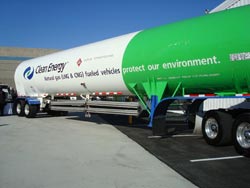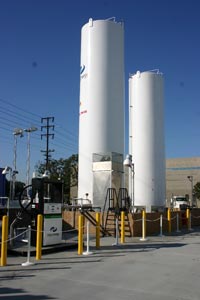
The Green Fleet
Could Clean Truck Deadline Leave Some Goods Dead in the Water?
- By L.K. Williams, EPonline
- Jul 24, 2008
 Brian Griley, president of Southern Counties Express (SCE), knows his industry. He is a third-generation trucking businessman, but the ports of Long Beach and Los Angeles are changing the rules of the road.
Brian Griley, president of Southern Counties Express (SCE), knows his industry. He is a third-generation trucking businessman, but the ports of Long Beach and Los Angeles are changing the rules of the road.
SCE, based in Rancho Dominguez, Calif., conducts about 70 percent of its business through San Pedro Bay terminals, moving containerized freight with 150 trucks for such companies as Nike, its affiliate Converse, and Kohl's. Last year's revenue topped $17 million.
In 2006, the Port of Long Beach and the Port of Los Angeles launched their Clean Air Action Plan (CAAP). According to Long Beach Mayor Bob Foster, "There's a slight difference in policy [between the ports], but they're both about the same size. If you look at them as a stationary source of air pollution, they would be the largest in Southern California."
No more dirty trucks
On Oct. 1, CAAP's Clean Trucks Program will stop short-haul trucks from moving cargo if they are not up to standard. Trucks built in 1988 or earlier will not be allowed at shipping terminals because they contribute substantially to poor air quality. By Jan. 1, 2010, only trucks built after 1993 will be allowed, and by Jan. 1, 2012, all trucks must meet 2007 federal emission standards. In the big picture, the ports expect to replace or retrofit 16,000 older diesel trucks to reduce air pollution by 80 percent within the next four years. The cleaner truck options discussed so far are clean diesel and liquefied natural gas (LNG). The ports can legally require cleaner trucks, Foster said, through the proprietary standard -- as property developers they can regulate activities on their land.
In 2006, the ports, along with Clean Energy, the largest provider of vehicular natural gas in North America, and Westport Innovations Inc., a company with expertise in natural gas motor technology, met with trucking executives to explain how LNG trucks work, what they cost, and how efficient they are.
"The truckers weren't buying in," Griley said. They argued that LNG trucks had no torque or range and got poor mileage. They considered the technology unreliable and the cost too great (about $200,000).
"I went home and thought to myself, 'I want to learn more about this.'"
So he did. SCE has tested an LNG-retrofitted Kenworth truck for nearly 2 years. This model uses Westport's High Pressure Direct Injection process to compress LNG in the heavy-duty Cummins ISX diesel engine. The main difference, according to Griley, seems to be in range. The LNG truck has a 320- to 350-mile range, requiring daily fuel stops, which doesn't compare well with diesel.
On the other hand, SCE drivers who have tested the truck seem to like it, Griley said, explaining that their wives can tell which truck they drove when they come home. The LNG truck leaves no odorous fumes.
 Fees and funding for the future
Fees and funding for the future
To offset some of the costs of the program, the ports approved a temporary fee of $35 per TEU (20 foot equivalent unit, or smaller freight container). Typically, that means $70 per haul per truck. At the Port of Los Angeles, Griley explained, the fee is waived if the driver has purchased a clean truck without funding help and is a company employee. At the Port of Long Beach, if you have purchased an LNG truck using public money, you are 50 percent exempt from the fee, regardless of the driver's classification.
One of the policy differences between the ports' Clean Trucks Program concessions is that Los Angeles wants to give company drivers access while Long Beach will accept company drivers as well as independent owner operators onto its terminals. SCE does business at both ports and currently operates using both types of drivers. Griley noted that it is good business to hire owner/ operators as they tend to get the freight moved more quickly.
Funds from the fees will be available as loans or grants for truck retrofits or replacement. The ports have said that the fee will end in 2012 when the short-haul truck fleet meets the CAAP requirements. The ports approved a $2 billion subsidy program to finance the lease or purchase of clean trucks.
Griley decided to take advantage of the financing. In March, SCE ordered 50 Kenworth LNG T800 Class 8 trucks, representing a $10.2 million value.
"SCE has stepped forward to be the first significant fleet adopter and can now realize the benefits of clean, cost-effective LNG trucks powered by Westport's high-efficiency, low-emission technology," said Michael Gallagher, Westport president and chief operating officer, in a press release. Those trucks were funded through the Port of Los Angeles grant program, Griley explained.
"The grant process made new LNG trucks affordable to owner/operators," Griley said. "The drivers are taking all the risk and deserve a break."
For each truck funded, one has to be scrapped. Griley said he has handed over $5,000 checks to owner operators and has accompanied some of them to the scrap yard, where the trucks they have driven for years become pieces of metal. Most of them end up back at the port, where the scrap is loaded onto ships that travel to recycling ports.
Fifty LNG trucks have helped grow The Green Fleet™, a division Griley started in 2007 to add alternative fuel, heavy-duty trucks to the company fleet. The Green Fleet will begin operation with LNG trucks owned by SCE and leased to owner/operator independent contractors. Griley said he was expecting to get the trucks into his yard by mid-July.
The division also partnered with Clean Energy to develop a fueling station and with Westport to build a maintenance facility, both at a site in Carson. Since Griley's company has been driving the LNG trucks, drivers had to refuel at Waste Management or airport facilities. The station, which also is designed for public use, cost more than $1 million to build and has been operating since December 2007. The Port of Long Beach is financing an LNG station near the ports.
 And now what?
And now what?
SCE now has port-compliant trucks, some employee drivers, and even the right fuel for the job, but when asked what was going to happen Oct. 1, Griley said, "Honestly, I don't know what we're going to do."
The American Trucking Associations has a plan that may make the issue moot. Curtis Whalen, executive director of the groups' Intermodal Motor Carrier Conference, plans to file by mid-July an injunction against the employee driver requirement from the Port of Los Angeles and against the concession structure proposed by both ports.
"We support the retirement of older truck fleets. We support the funding programs designed to get newer trucks on the road. We object to, first and foremost, the Port of Los Angeles' and the Teamsters' insistence on banning owner/operators. By law, these drivers cannot be organized by the union, and this frustrates the Teamsters," Whalen said.
The concession proposal, Curtis explained, is designed to reduce the number of carriers. There are 1,300 now. The structure would require carriers to meet specific criteria to qualify to do business on and sign contracts with the ports. "This is a blockade to activity otherwise deregulated," he said.
Whalen expressed doubt as to whether the ports would meet their own deadline because they have yet to publicize the process for concessionaires or hire an administrator for the program.
"Local governments and ports can't do those sorts of things as they relate to interstate traffic," Whalen said. But apparently they can try.
Whether the court stays a portion of the plan or scraps the whole thing, Griley has accepted the inevitable: "Things are going to have to be green."
About the Author
L.K. Williams is the Environmental Group Editor of 1105 Media.